How To Write An About Us Page For A Blog
Learning how to write an About Me page that can capture the attention of your readers, clearly articulate why your blog exists and tell a compelling story, is a skill that's highly underrated today.
And despite the fact that overall content quality has increased consistently over the years, I've noticed a strange trend on most of the blogs I follow—a lot of their About Me pages are either poorly written or largely neglected (thus missing a lot of opportunities where the blogger could instead be better selling themselves to their readers). It's not that these about pages are packed with grammatical errors or formatting mistakes, it's that most About Me pages are dramatically underserving their purpose.
That's why every blogger needs to invest some time into learning how to write an About Me page that can (1) introduce yourself effectively and (2) tell a compelling story about why your readers should care to consume your content. Whether you're just starting your blog and are yet to write your own About Me page—or you've already written one and feel it could use a face lift, this guide will walk you through all of the steps in writing a winning About Me page.
How to Write an About Me Page for Your Blog in 6 Easy Steps
- Clearly Communicate Your Value Proposition
- Curate the Hero Section of Your About Me Page
- Tell a Compelling Story (Not Your Entire Life's History)
- Use Your About Page to Sell Yourself to Readers
- Nail Your Calls-to-Action on Your About Me Page
- Make Thoughtful Design and Layout Decisions
Disclosure: Please note that some of the links below are affiliate links and at no additional cost to you, I'll earn a commission. Know that I only recommend products and services I've personally used and stand behind. When you use one of my affiliate links, the company compensates me, which helps me run this blog and keep all of my in-depth content free of charge for readers (like you).
Quickly, before diving into my guide about how to write an about page for your blog, let's cover a couple of pressing relevant questions (click to expand and read each answer).
What is an About Me page?
Chances are, an About Me page isn't exactly what you think it is. It's not just that one page sitting far off in the corner of your blog where you're expected to gloat about your achievements and spill every detail of your life story. Like my own right here, an About page can be so much more.
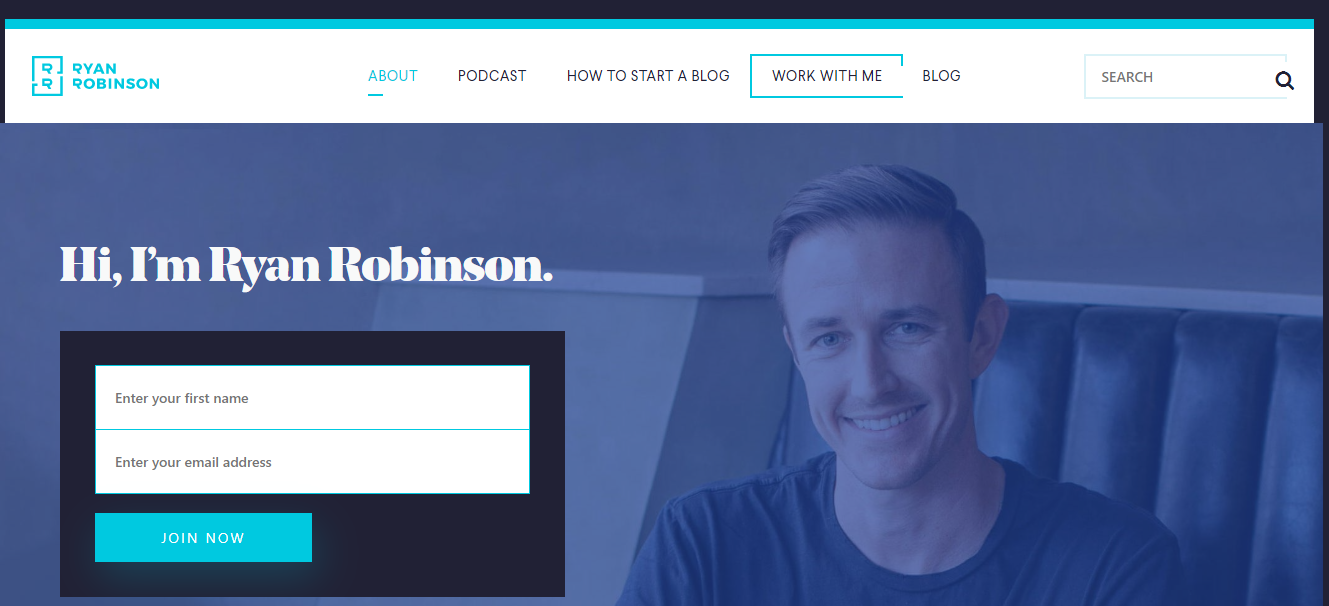
In its best form, an About Me page is essentially a page on your blog that tells the story about why your blog exists—from the perspective of why your readers should care.
That means introducing yourself and telling your story in a way that shows your readers the exact ways in which they'll benefit from following along with your blog. Getting this right is absolutely crucial, as people rarely visit a blog solely because they're interested in you (ouch!). The vast majority of people on the Internet are most interested in what they can learn from you. And that's why your About Me page must be written from the perspective of showing your readers why they should care about your blog.
Why is having an About Me page so important?
Without understanding the true value and importance of having a great About Me page, many a bloggers simply treat it as an afterthought. The resulting page, is a few paragraphs slapped together about their work experience and a couple pictures with their favorite pet—or even worse, some don't bother to write an About Me page at all.
So why should you spend time writing an About Me page for your blog? Well, aside from the fact that 52% of website visitors report regularly visiting a brand's About page, I'll give you 3 more good reasons why.
1. An About Me Page Connects You to Your Readers
One of the biggest reasons you should spend time writing a great About Me page, is that it's the perfect opportunity to establish a meaningful connection with your readers (on an emotional level). Crafted well, an About Me page will resonate deeply with your target audience, making your content that much more relatable to them.
2. An About Me Page Sells Your Brand
Another reason your About Me page is so important, is that it's one of the best opportunities you have to sell your brand. Keep in mind though, that people don't like brands that push themselves too aggressively. Instead, most people say they'd rather partner with brands that share the same values. And this is exactly where your About Me page comes in—it helps you sell your brand by showing your target readers that you share the same values (and goals). Plus, if the name of your blog doesn't immediately communicate what the subject matter of your content is (like my blog's name, ryrob), then your about page serves as a priceless opportunity to explain why you choose that name—and connect your site's name to the greater purpose it serves.
3. An About Me Page Builds Trust and Authority
One of the most important assets you can ever acquire (online and offline) is trust. Your About Me page can significantly help earn the trust and respect of your readers. If written well, your About Me page will prove to your readers that they can trust you as a reputable source of information and advice.
Beyond just establishing trust, highlighting your authority within your blog's niche is another key role that an About Me page can serve, aiding greatly in your ability to build a strong following. An effective About Me page can position you as an expert in your field, which will become increasingly essential to the success of your blog business plan over time.
Now that you understand what an About Me page can do for your blog (and why it matters so much), let's dive into how to write an About Me page for your own blog. And since we'll be using my own about page as a case study example throughout this guide, you can click right here to see it and follow along.
1. Clearly Communicate Your Value Proposition
The very first thing you need to clarify before you write an About Me page for your blog, is what your value proposition is. Put simply, a value proposition is a statement that conveys what you have to offer your readers. In other words, answer the question, what does your audience stand to gain by following your blog?
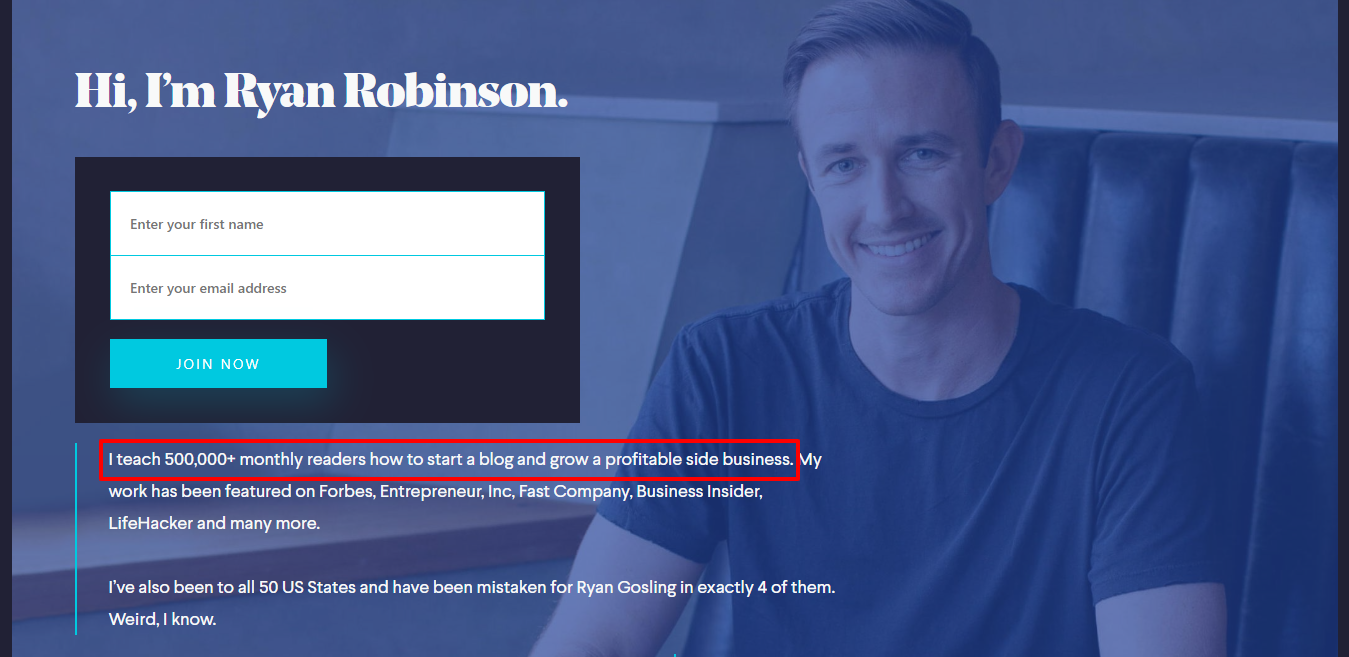
As you can see in the screenshot above, the one-sentence value proposition I lead with on my About Me page is: "I teach 500,000+ monthly readers how to start a blog and grow a profitable side business."
After many years of experience in my niche, I've been able to sharpen my big promise down to just one line for readers to decide whether or not that resonates with them. To most of the readers that find my blog by searching for blogging tips and related advice, this promise really hits the nail on the head.
Why is it important to clearly articulate your value proposition on your About Me page?
- Set's you apart. Let's face it, your blog isn't the only one that publishes the kind of content you create. Your value proposition is what differentiates you from the other blogs in your niche.
- Shows the benefits of following your blog. What will your readers gain from following your blog? This must be clearly expressed and communicated in your value proposition.
Now, it's your turn. If you haven't already crafted a value proposition statement that highlights the top-level takeaways you want readers to gain from your blog, give it a try right now.
Remember, your value proposition is a statement that (1) explains exactly what makes your blog different from others in your space and (2) tells readers what they'll get from your site. Once you've worked that message out, be sure your About Me page leads with your clear value proposition—so that readers will immediately know if your content will be right for them.
2. Curate the Hero Section of Your About Me Page
The hero section is everything readers will see immediately when they land at the top of your About Me page, so it makes sense that you'll want to make a great first impression.
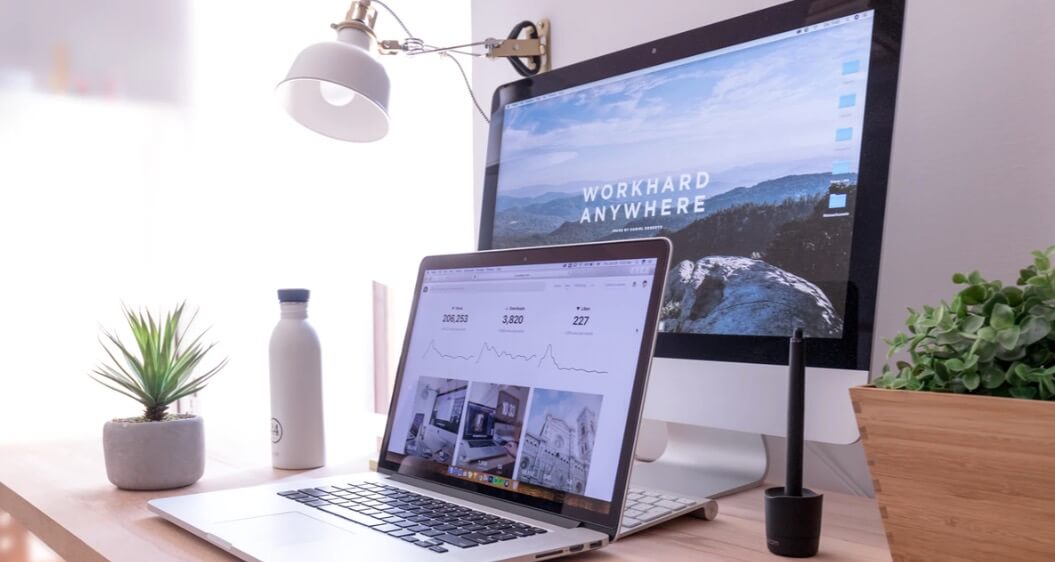
In your hero section, you'll want to accomplish three main goals:
- Greet your blog visitors. Personalize your greeting (to speak directly to your target audience) and make sure it's written in a friendly tone.
- Introduce yourself. Tell your visitors who you are, what you do and why you do it. Be succinct here, you can expand on these points later.
- Point out your value proposition. This is where you'll want to introduce your value proposition and hook readers into continuing onward.
So, how do you curate the perfect hero section for your About Me page? Let's dig in.
Image is Everything in Your About Me Hero Section
The reason (most) people search for information on the Internet, is that they're looking for solutions that can lead them away from their pain point and into happiness. This is why the hero section of your About Me page is an incredible opportunity to position yourself as the solution provider your audience is looking for. One element of the hero section that helps portray this, is a high quality head shot image. Like mine:

Your head shot communicates a lot about who you are. More than that, if taken well, it can even be a trust-building tool. Here are a a couple of tips for taking a great head shot to include on your About Me page:
- Be you. Above all else, your blog should be a place where you can unabashedly be yourself. That detail should certainly be taken into account when you're taking a head shot for your About Me page, so don't go out of your way to force a look or stage a scene that isn't who you really are.
- Show your pearly whites. Research suggests that smiling evolved to become pre-programmed behavior in humans that's designed to express friendliness (and to show no threat) toward one another. So, if it feels natural, consider giving your readers a warm smile or an inviting look in your head shot. Smiling while showing your teeth makes you appear friendly, approachable, caring and relatable.
- Watch where you look. You have 2 options here. The first option is to look straight into the camera, as this makes it feel like you're focusing directly on the reader—giving them 100% of your attention. The second option is to look towards the text, preferably at a call-to-action you have on the page. This directs attention and encourages readers to click, signup or take whichever action you'd like.
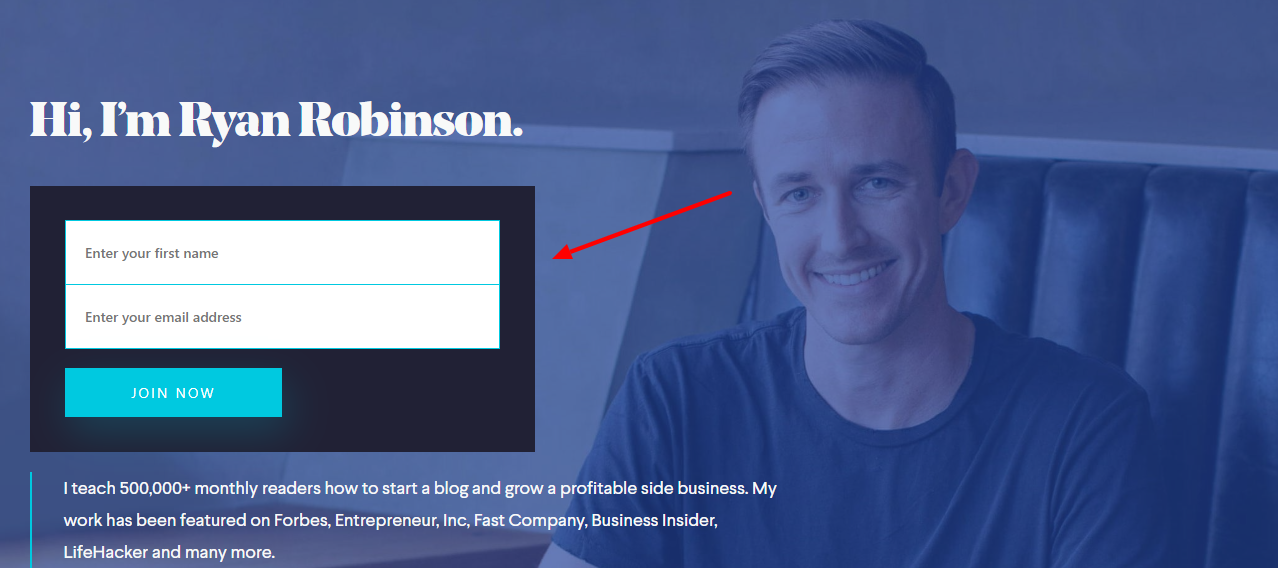
Build Authority with Your About Me Hero Section
Your readers have many options when it comes to which blog they should follow for information and advice in your industry. Thus, your hero section should give them ample reason to follow yours (and confidence in that decision). One of the best ways to do this quickly within your hero section, is to establish your authority. This means showing readers why they should listen to you.
How do you do that? With a little bit of humble bragging. Here's an example—the second sentence in the hero section of my About Me page is: "My work has been featured on Forbes, Entrepreneur, Inc, Fast Company, Business Insider, LifeHacker and many more."
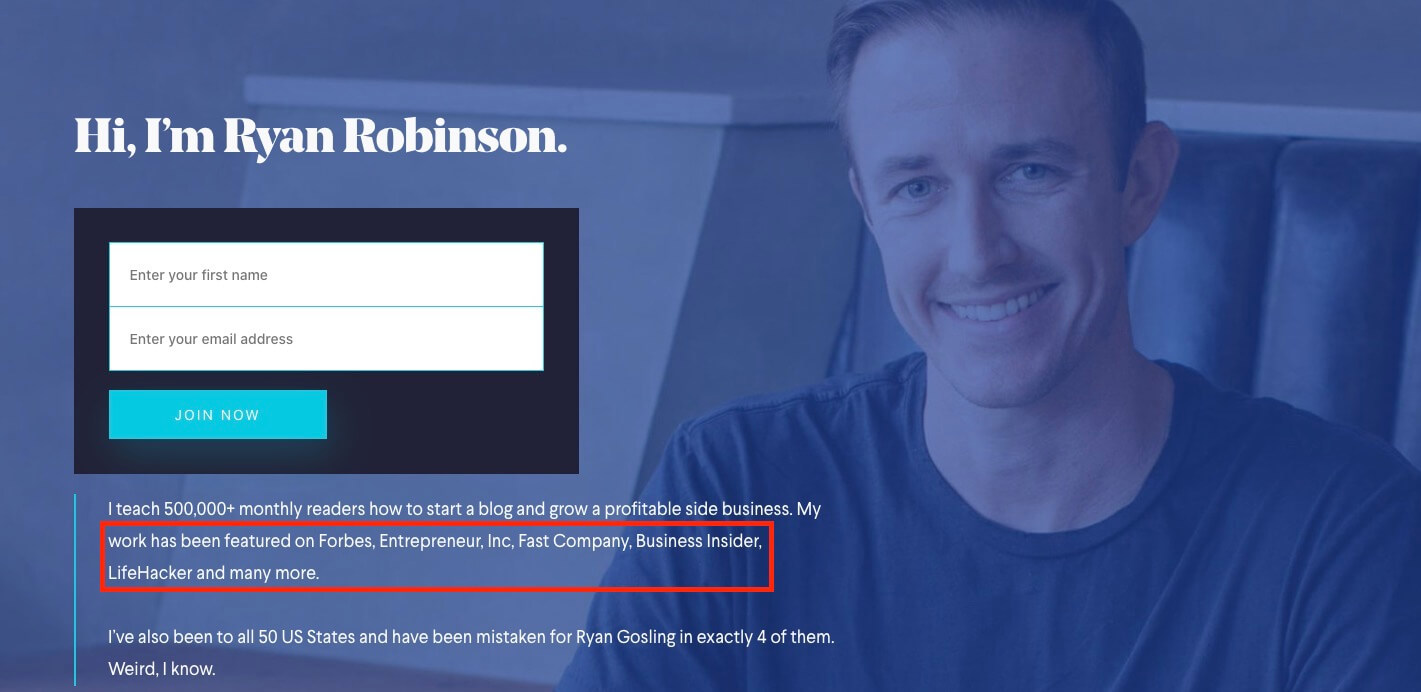
To the readers in my target audience that land on my about page, just about all of them will recognize the names of these world-renowned business publications, which lends me some immediate authority.
Use the hero section of your About Me page to highlight your victories, both past and present. This'll show your readers that you've already walked the path you're now teaching others. And that's what people are really looking for—someone who's been where they are now, and has accomplished exactly what they're looking to achieve.
Break the Ice and Humanize Yourself
Reading an About Me page is the online equivalent of meeting someone for the first time (in-person) in the physical world. In many cases, people are a little bit apprehensive and not too sure about what they should expect from you during a first encounter. Because of this built-in nature we have as humans, we tend to immediately put up our psychological defenses.
That's why you need to write an About Me page that includes an icebreaker near the top of your hero section.
One of the best icebreakers you can employ is humor. Laughter almost always helps people lower their defenses and relax a bit. Tell a quick funny story, offer a fun fact or share an experience your readers will find entertaining in your hero section. See the second paragraph of my own About Me hero section: "I've also been to all 50 US states and have been mistaken for Ryan Gosling in exactly 4 of them. Weird, I know."
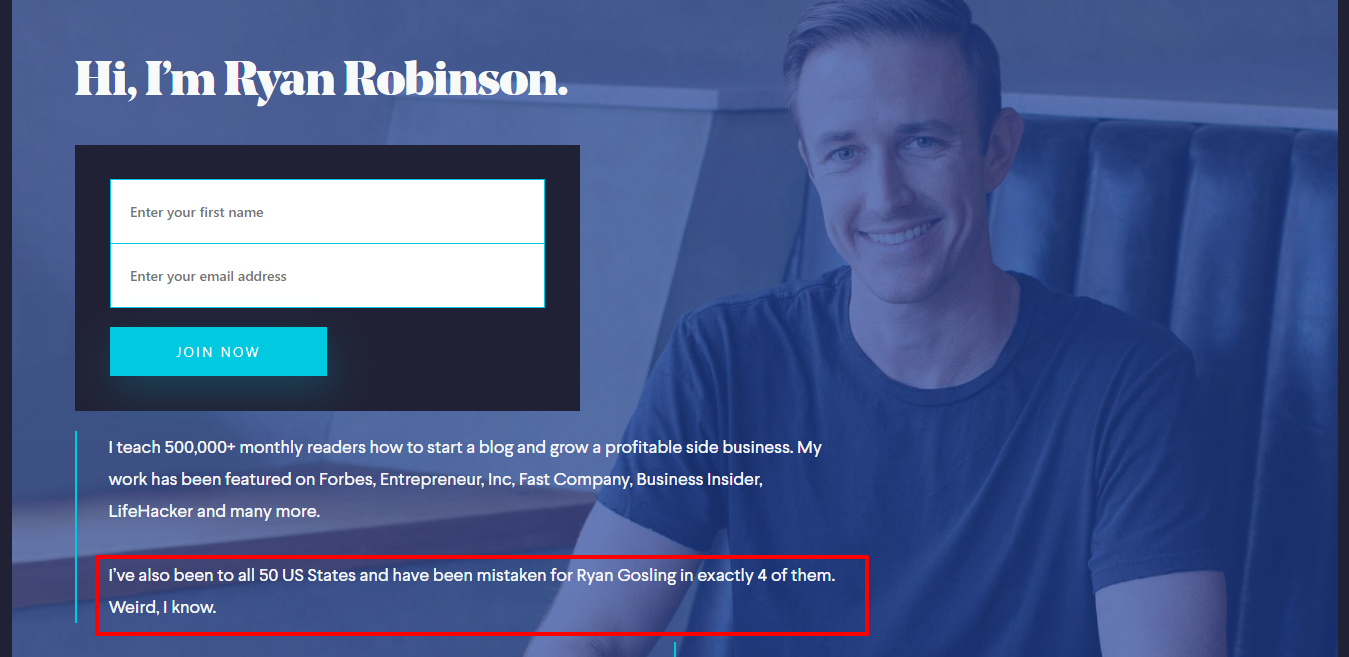
Not only will sharing a funny little fact put your readers at ease right away, but it'll also help illuminate your human side—thus making you much more relatable to them (rather than positioning yourself as some lofty guru to be placed on a pedestal).
3. Tell a Compelling Story (Not Your Entire Life's History)
One of the easiest mistakes you can make when learning how to write an About Me page for your blog, is to ramble on about yourself without a clear purpose in mind. Yes, it's an About Me page, but that doesn't mean you should push your entire resume (or life's history) on your about page, and you don't need to deploy your powers in the writing faster department here.
Instead, focus on telling your story in a colorful way—don't just bullet point the facts, highlights and statistics. Have fun with your story and be creative in connecting with your readers.
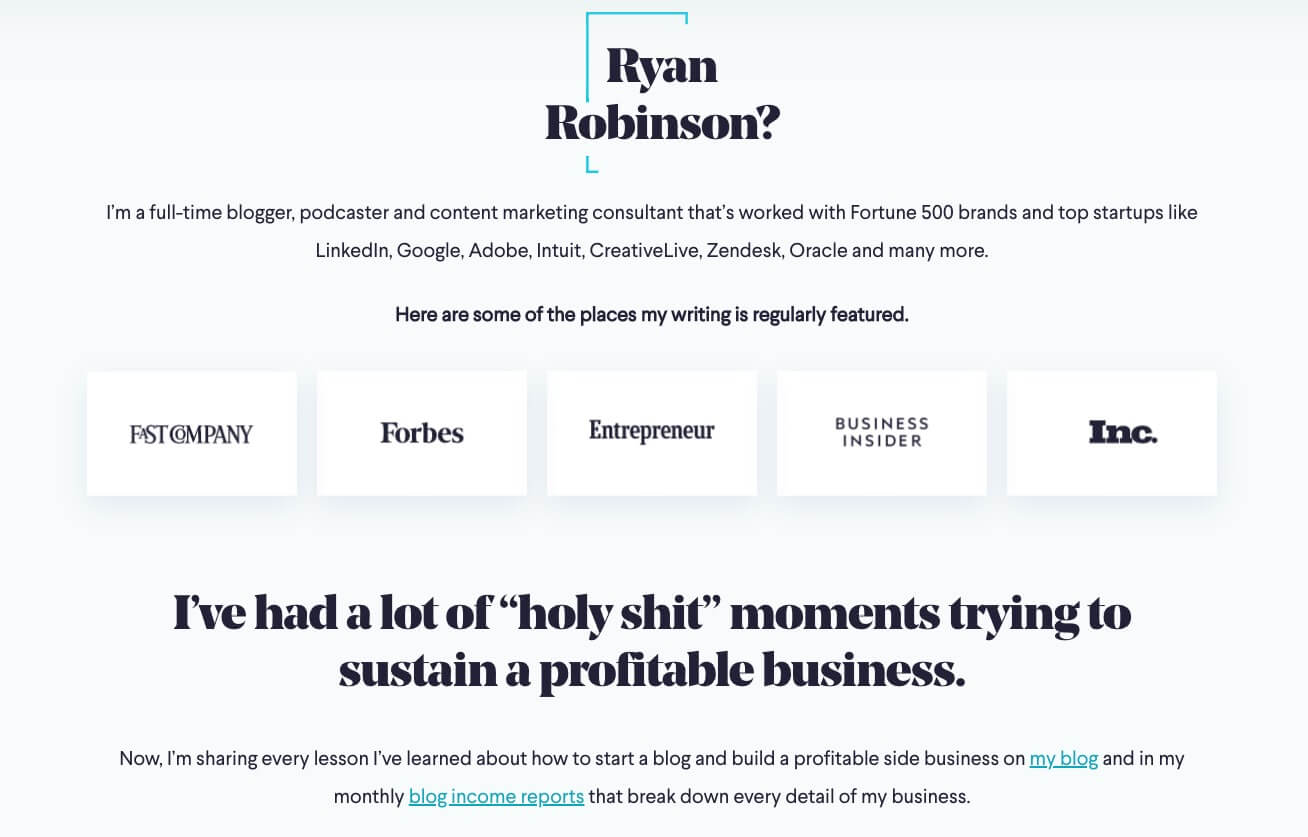
Unless you're an A-list celebrity, the truth is that most people don't want to know every single little detail about you.
However, the one thing your readerswill want to know about you is how you transformed from being "ordinary" in your niche—to achieving the success you've had today (thus lending confidence to your readers placing trust in choosing you to learn from). In order to do that in an engaging manner that actually keeps readers on your About Me page, you'll have to hook them with storytelling.
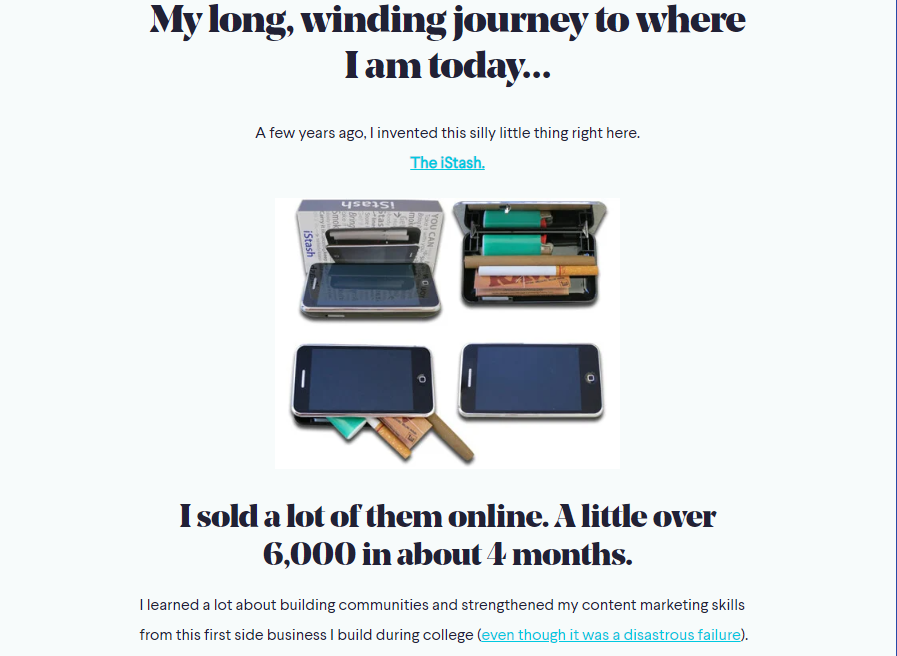
People love a great story, especially when it involves an initial failure that turns into eventual victory. So don't be afraid (or ashamed) to share your scars—they'll make you more relatable, and are powerful in educational storytelling.
More importantly, sharing your failures will help illustrate to readers that failure is a necessary part of the process—especially when it comes to growing a blog and figuring out how to promote your content. It takes time to go from beginner to expert in any field, so being up front in sharing your own humility along that journey is key. It's also a great way of rescuing those who are down in the dumps, on the verge of giving up.
Another mistake to avoid when writing an About Me page for your blog, is to make your story feel closed-ended. In other words, don't make it feel like you've already achieved all your goals.
People want to follow leaders (that's what you are when people follow your blog) who are still making moves, trying new things, growing and progressing in their fields.
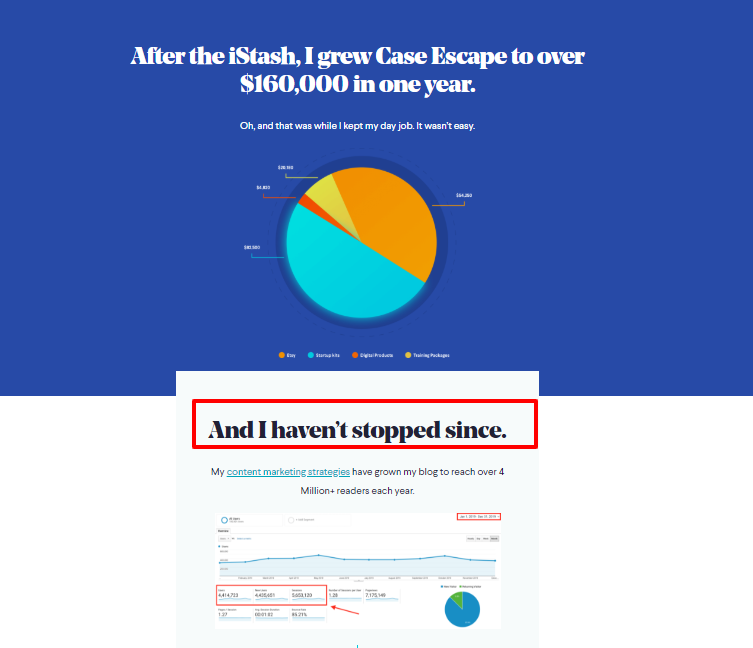
Your About Me page should read like a journey in-progress, not just a static map for readers to take a quick look at.
One of the primary goals of learning how to write an About Me page that works for you, is to give your readers a high degree of confidence in that choosing to follow you, they'll be able to break into uncharted territory in their lives.
4. Use Your About Page to Sell Yourself to Readers (and Prospects)
Whether you realize it or not, your About Me page is one of the most important sales pages on your blog.
Yes, you read that right. One of the main reasons for learning how to write an About Me page isn't to brag or tell readers about all your favorite hobbies. One of its primary purposes is to sell yourself (and your blog) to your readers. In order to do that, you must tastefully call attention your expertise without overtly bragging or distancing yourself from your readers.
There are two ways you can choose to sell your strengths to your readers on your about page:
Tell Readers About Your Achievements
Naturally, you can use your words to tell readers what you've accomplished. Of course, you'll want those accomplishments to relate to the purpose of your blog and what your readers need your help with.
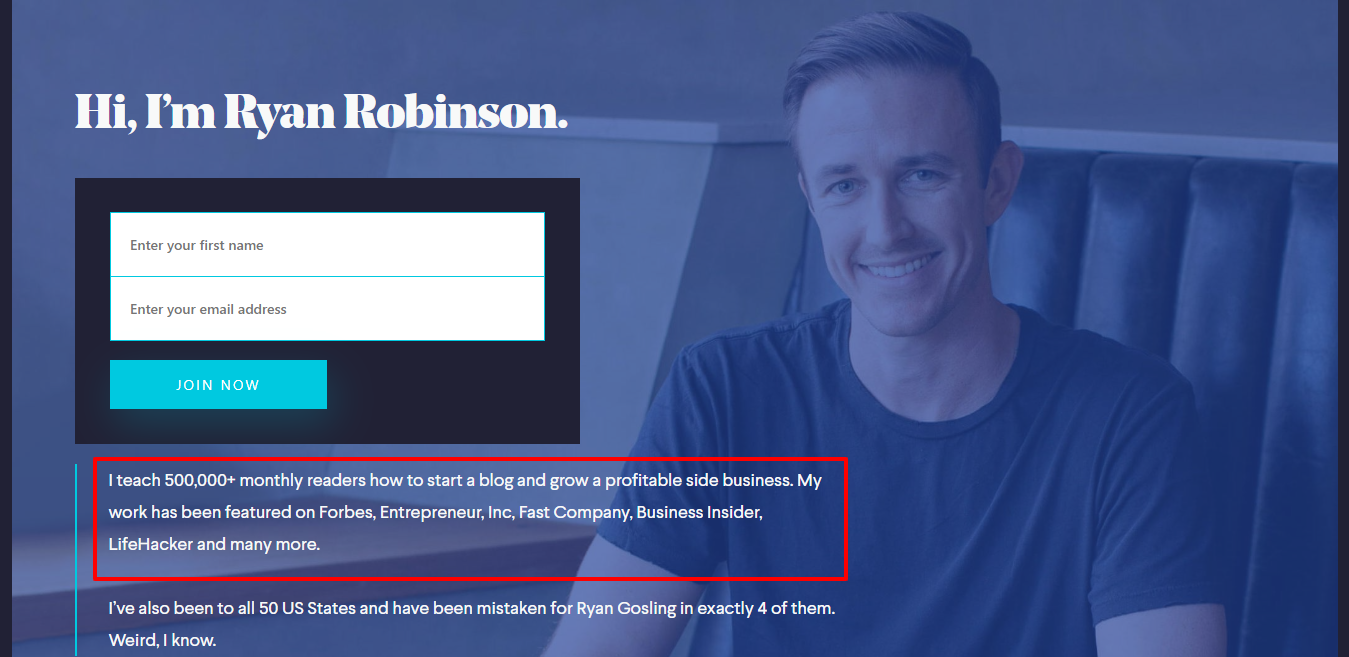
Show Readers Your Achievements
A much more effective way to sell yourself to your readers, is to show them your expertise—and the best way to do that is by using eye-catching visuals that can quickly relate what you've accomplished. One way you can easily do this, is by showcasing the logos of some of the brands you've either worked with, been featured on or have done guest blogging work for.
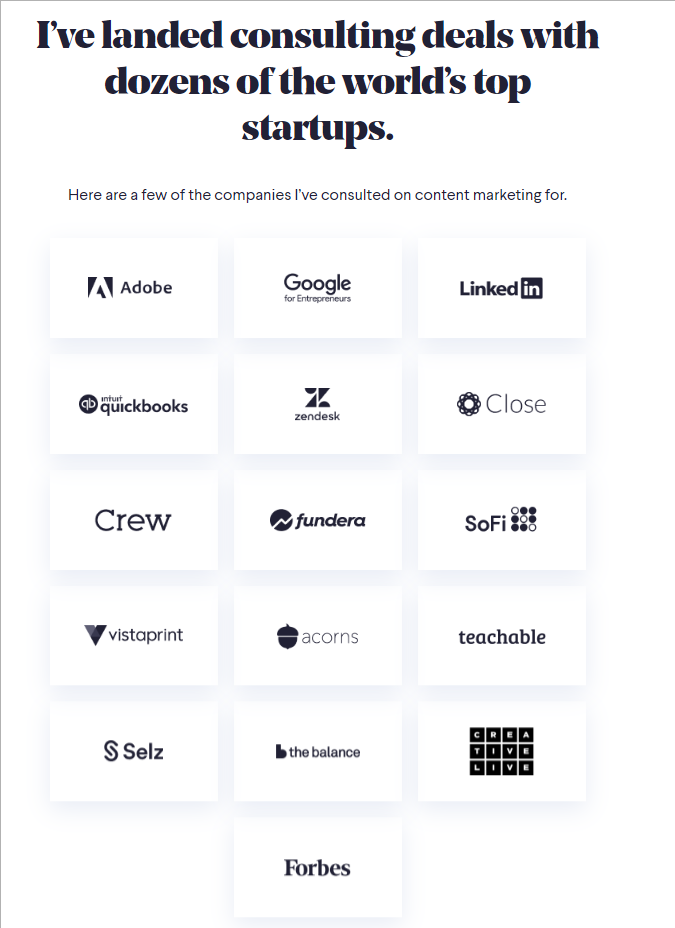
Again, people buy into learning from the people they trust—those that walk the talk, not just talk the talk.
This is why using the 2-pronged approach of showing and telling is so important when it comes to selling yourself on your blog's about page.
Sell Your Expertise While Offering Your Friendship
Still on the subject of positioning yourself as an expert, it's extremely important that you be careful in how you choose to do this—lest you run the risk of turning readers away.
That means really framing yourself as a friendly, approachable expert that's not "above" working with and helping people who are just getting started in their fields.
As much as you are an expert in your niche, strive to be one that's friendly, approachable and easily relatable. People should trust you enough to lead them, and yet also feel like you're a friend they can turn to for reliable advice.
5. Nail Your Calls-to-Action on Your About Me Page
By this point on your About Me page, your readers will be somewhat well acquainted with you—and understand what you have to offer. So, what's next? Don't take it for granted that the visitors to your About Me page will instinctively find their way to other key pages on your blog.
Use this as an opportunity to direct readers to exactly where you think they need to be next—which is why your About Me page must always at least one clear call-to-action on it.
Tell readers what they should do next at each stage of getting to know you. For example, I let readers know which social media platform I'm most active on and immediately invite them to connect with me there:
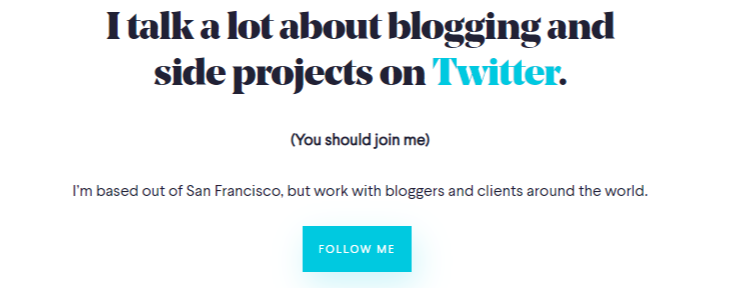
Further down my About page, I introduce readers to my podcast and insert a clear call-to-action asking them to give the show a listen if they're interested in stories about business ideas that've grown from side hustle to full-time endeavor:
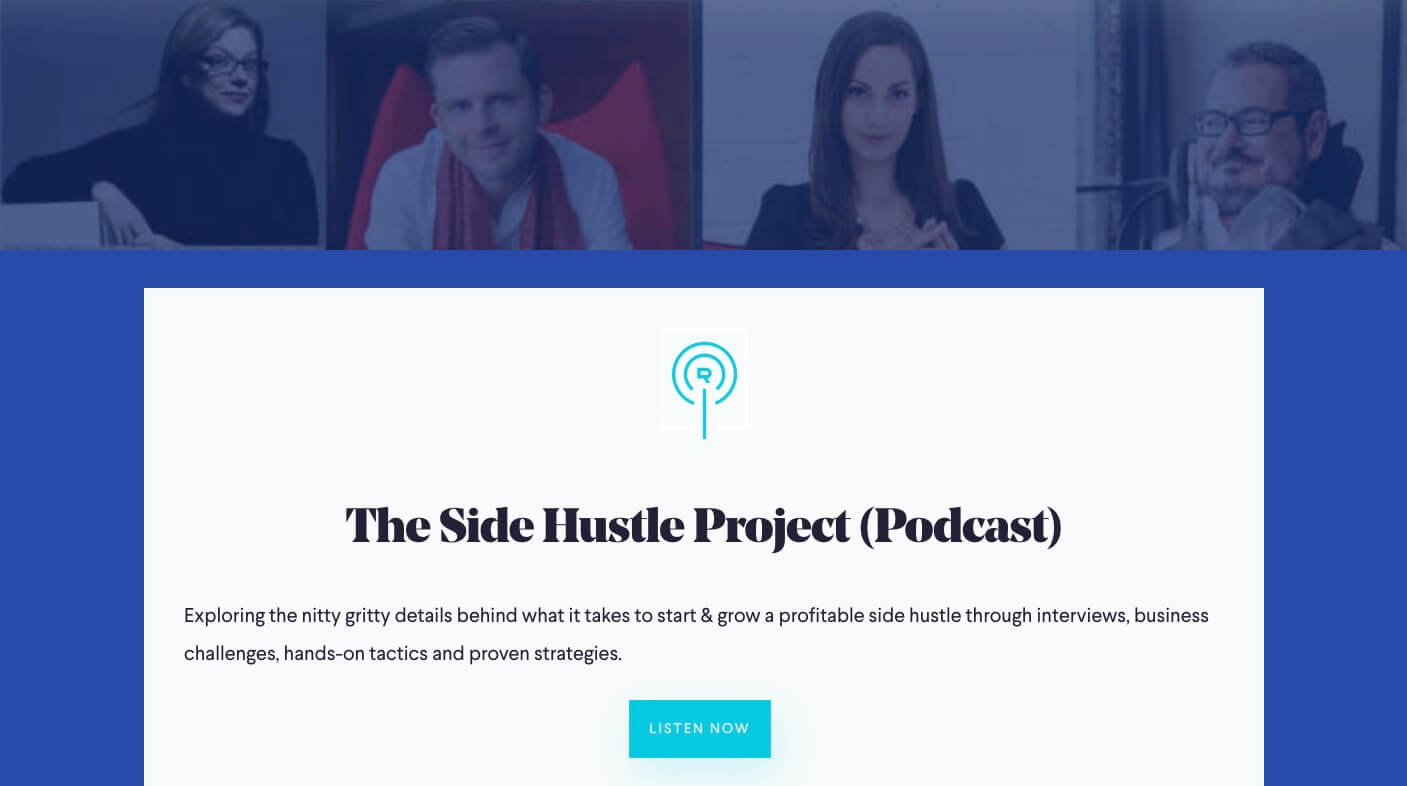
Your About Me page should serve as a central hub where readers can access all of your most important pages, blog posts and assets you want them to know about.
And when readers scroll down to the very bottom of your About page, I recommend placing a final (prominent) call-to-action that invites them to reach out to you for the services you offer—or if you don't offer any services yet, just to ask a relevant question that you can help by answering. I've gotten hundreds of emails from readers who've taken me up on this offer from my About Me page:
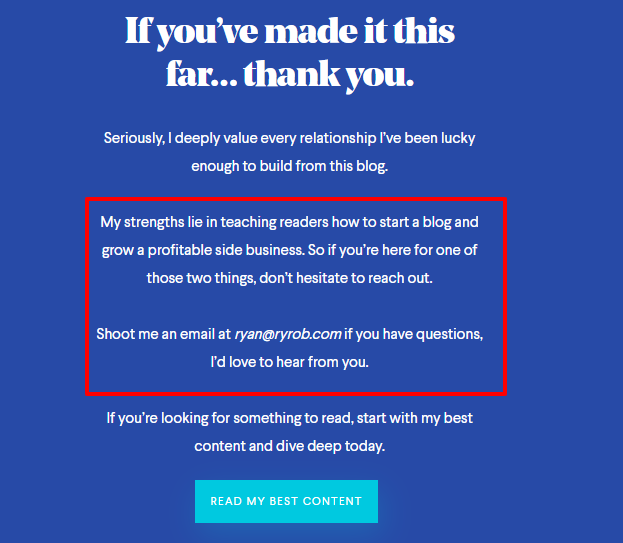
This call-to-action is particularly important, because it shows your readers that you're there to help them realize their goals. By opening up a line of communication, you establish that the relationship you have with your readers is 2-way, thus reinforcing the trust you've been building with them throughout your About Me page.
And now that your readers have read through the entirety of your About Me page, there still are a couple more important calls-to-action you need to include.
Consider them navigational CTAs if you will, as their purpose is to direct readers to other important pages across your blog. The primary navigational CTA I enlist at the bottom of my About Me page, is to send readers over to a directory of all my best content (where they can discover hundreds of my long-form instructional guides to help with every step of the blogging journey):
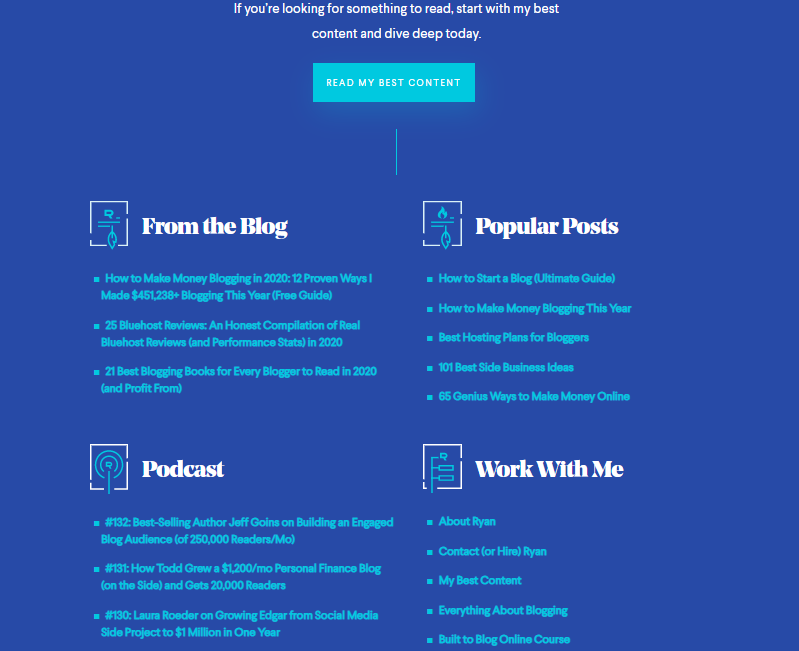
Neglecting this final section of calls-to-action could mean you're running the risk of most readers leaving your blog's About Me page before really seeing what you have to offer in terms of the content and services you provide.
Calls-to-action are important elements of your About Me page and should also look good—which means designing them well. Here are a couple of tips on designing your CTAs:
- Use buttons for important CTAs. Buttons visually pop on the page and should be used to direct readers to complete important actions. For secondary CTAs, clickable links will suffice.
- Use the active voice. Using active voice (as opposed to passive voice) in your CTAs is crucial to conversions, because the active voice elicits an immediate response. Here's an example:
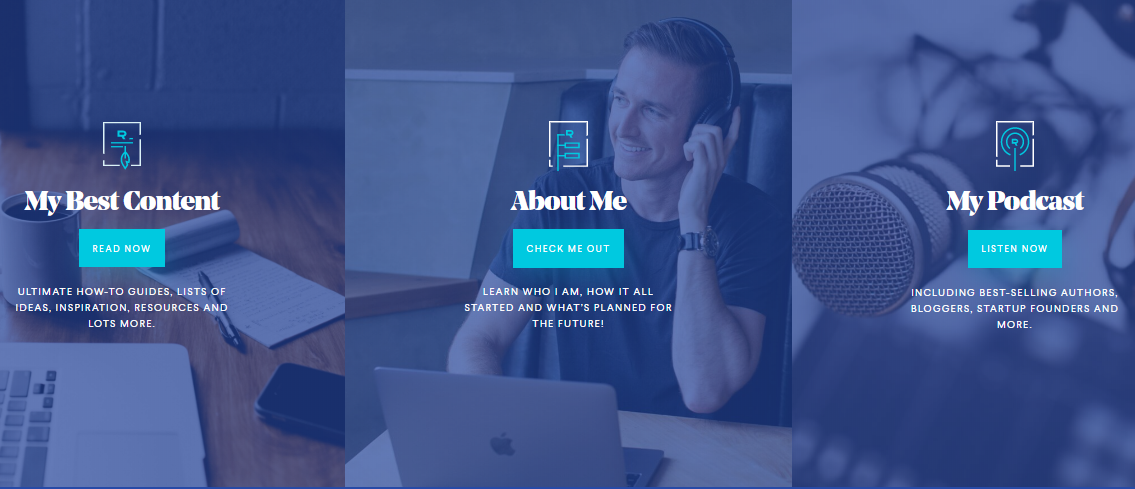
6. Make Thoughtful Design and Layout Decisions
The last aspect you need to nail when creating an About Me page is the design and overall blog layout you choose to use on the page.
As it can one of the key pages on your blog, your About Me page should be attractive and compelling—it must impress the readers that land on it. To achieve this, focus on these three objectives:
- Balance text with graphics. For your About Me page to be aesthetically pleasing, you must play the delicate game of balancing your text and graphics well. This'll help keep your readers engaged with a good amount of eye candy, while still educating them through text as well.
- Watch the flow. Especially when transitioning from one section to another, make sure there's a good flow of ideas and conversations. Any break in flow is a distraction and can lead to your readers bouncing off the page.
- Stick to your branding. As a blogger, you have a brand (whether you realize it or not). That includes your voice and tone, as well as color palette, which should inform the copy and visuals you use on your About Me page. In other words, when a visitor moves from your About Me page to another page or post on your blog, they should have an experience that feels the same.
Every design element on your About Me page should communicate both your personality or your vision, which means that your design should serve both form and function.
For all of my best practices on designing a thoughtful layout for your blog (including all of the tools I use to do it here on my own blog), check out: 12 Blog Layout Examples and Best Practices.
How to Write an About Me Page Final Takeaways: 5 Best Practices to Follow Today

Are you ready to write a better About Me page for your blog?
Great! Now, before you rush off to write your About Me page, make sure to follow these important best practices:
Always Write an About Me Page the Way You Speak
Your blog is an extension of who you are. As such, the content you create on it should convey your personality. On your About Me page, the best way to do that is to write exactly as if you're talking to the individual reader that's on the page. A conversational tone is also important to keeping your readers engaged throughout the entirety of your page.
Be Honest and Show Humility
Honesty is always the best policy—especially when writing an About Me page where you hope to build genuine relationships with your readers. Be honest about your strengths, skills and experiences. Don't stretch the truth for the sake of making your story more interesting. If you do that and your readers find out, you'll lose their trust—and it'll be next to impossible to win it back.
Avoid Rambling
As much as it's tempting to share a ton of your life experiences, try to fight that temptation and pare your About Me page down to the essentials. If unchecked, a rambling story can be a total turn off that also reduces the quality and impact of your content. The result, of course, is that many first-time readers will be more likely to bounce off your About Me page—never to return again.
Use High Quality Images
Images play a major role in helping you tell a great story. For that reason, if you need to use stock images on your About Me page, I'd highly recommend Unsplash. But more importantly, when it comes to the hero image (ideally of yourself) near the top of your blog's About Me page, it helps to showcase yourself in a thoughtful way. This one image is an opportunity to show readers how you want to relate to them, and can drive home the image that you mean business when it comes to helping them achieve their goals in your industry.
Internal Linking is Crucial
Internally building links to your key content is another (often overlooked) aspect of writing an About Me page. And yet building internal links serves two very important purposes:
- Improves user experience. By providing your readers with links that take them to other pages of your blog, you'll make it easier for them to find their way around your blog.
- Boosts your blog's SEO. Internal links play an important role in search engine optimization (SEO) as the links help search engines crawl your website more easily. It'll also help boost your About Me page in the search results when someone searches for your name online.
However, don't just add a ton of links for the sake of linking alone. Every link to and from your About Me page should be relevant, contextual and add real value.
Ready to Write an About Me Page for Your Blog?
Now you're fully prepared to go out and write an About Me page for your blog—one that'll clearly convey your value proposition, capture reader attention and convert them into loyal followers.
Remember, it may be called an About Me page, but it isn't really about you. It's about how you can help your audience and why they should trust you to do so.
For more advice on how to succeed with your blog, check out these in-depth guides that'll steer you in the right direction:
- How to Write a Blog Post (That'll Attract Readers)
- 21 Blogging Books to Take Your Blog to the Next Level
- My Best Practices for Outlining a Blog Post
- 27 Blogging Courses to Advance Your Knowledge
- The Art and Science of Writing Blog Headlines
- 201+ Blog Post Ideas to Spark Your Creativity
- How to Drive Traffic to Your Blog (32 Strategies)
- How to Make Money Blogging This Year
- 40+ Blogging Tools to Help Grow Your Blog
Ready to Start Your Blog Today?
Check out my ultimate guide How to Start a Blog (on the Side).
How To Write An About Us Page For A Blog
Source: https://www.ryrob.com/how-to-write-about-me-page/
Posted by: garciagratin.blogspot.com

0 Response to "How To Write An About Us Page For A Blog"
Post a Comment